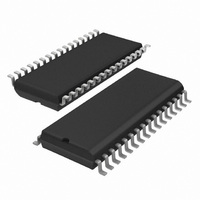PCA9625D,518 NXP Semiconductors, PCA9625D,518 Datasheet - Page 14

PCA9625D,518
Manufacturer Part Number
PCA9625D,518
Description
IC LED DRIVER RGBA 32-SOIC
Manufacturer
NXP Semiconductors
Type
RGBA LED Driverr
Datasheet
1.PCA9625D512.pdf
(33 pages)
Specifications of PCA9625D,518
Package / Case
32-SOIC (7.5mm Width)
Topology
Open Drain, PWM
Number Of Outputs
16
Internal Driver
Yes
Type - Primary
Backlight, LED Blinker
Type - Secondary
RGBA
Frequency
1MHz
Voltage - Supply
2.3 V ~ 5.5 V
Voltage - Output
24V
Mounting Type
Surface Mount
Operating Temperature
-40°C ~ 85°C
Current - Output / Channel
100mA
Internal Switch(s)
Yes
Low Level Output Current
100 mA
Operating Supply Voltage
2.3 V to 5.5 V
Maximum Supply Current
10 mA
Maximum Power Dissipation
100 mW
Maximum Operating Temperature
+ 85 C
Mounting Style
SMD/SMT
Minimum Operating Temperature
- 40 C
Lead Free Status / RoHS Status
Lead free / RoHS Compliant
Efficiency
-
Lead Free Status / Rohs Status
Details
Other names
935285131518
PCA9625D-T
PCA9625D-T
PCA9625D-T
PCA9625D-T
NXP Semiconductors
PCA9625_2
Product data sheet
7.3.8 ALLCALLADR, LED All Call I
7.4 Active LOW output enable input
Once subaddresses have been programmed to their right values, SUBx bits need to be
set to logic 1 in order to have the device acknowledging these addresses (MODE1
register).
Only the 7 MSBs representing the I
register is a read-only bit (0).
When SUBx is set to logic 1, the corresponding I
either an I
Table 12.
Legend: * default value.
The LED All Call I
at the same time (ALLCALL bit in register MODE1 must be equal to 1 (power-up default
state)). This address is programmable through the I
an I
Sub Call.
Only the 7 MSBs representing the All Call I
ALLCALLADR register is a read-only bit (0).
If ALLCALL bit = 0, the device does not acknowledge the address programmed in register
ALLCALLADR.
The active LOW output enable (OE) pin, allows to enable or disable all the LED outputs at
the same time.
The OE pin can be used as a synchronization signal to switch on/off several PCA9625
devices at the same time. This requires an external clock reference that provides blinking
period and the duty cycle.
The OE pin can also be used as an external dimming control signal. The frequency of the
external clock must be high enough not to be seen by the human eye, and the duty cycle
value determines the brightness of the LEDs.
Remark: Do not use OE as an external blinking control signal when internal global
blinking is selected (DMBLNK = 1, MODE2 register) since it will result in an undefined
blinking pattern. Do not use OE as an external dimming control signal when internal global
dimming is selected (DMBLNK = 0, MODE2 register) since it will result in an undefined
dimming pattern.
Address
1Bh
•
•
2
When a LOW level is applied to OE pin, all the LED outputs are enabled.
When a HIGH level is applied to OE pin, all the LED outputs are high-impedance.
C-bus read or write sequence. The register address can also be programmed as a
2
Register
ALLCALLADR
ALLCALLADR - LED All Call I
description
C-bus read or write sequence.
2
C-bus address allows all the PCA9625s on the bus to be programmed
Rev. 02 — 15 January 2008
Bit
7:1
0
Symbol
AC[7:1]
AC[0]
2
C-bus address
2
C-bus subaddress are valid. The LSB in SUBADRx
2
C-bus address register (address 1Bh) bit
2
16-bit Fm+ I
Access Value
R/W
R only
C-bus address are valid. The LSB in
2
C-bus subaddress can be used during
2
C-bus and can be used during either
1110 000*
0*
2
C-bus 100 mA 24 V LED driver
Description
ALLCALL I
address register
reserved
PCA9625
© NXP B.V. 2008. All rights reserved.
2
C-bus
14 of 33














